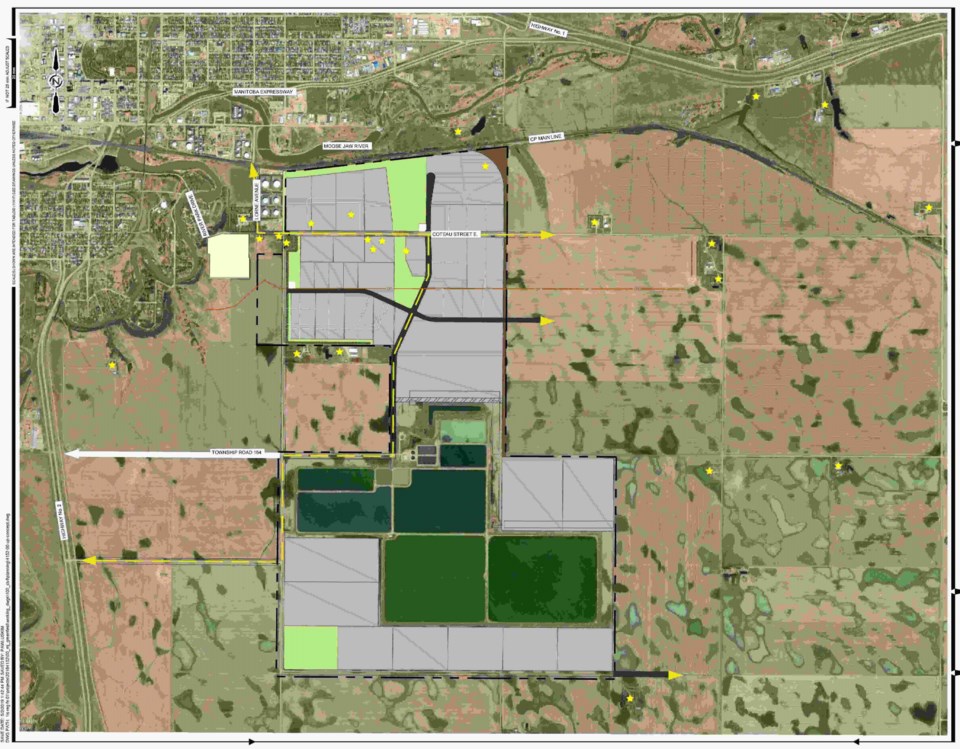With the collapse of the Carpere Canada deal, Moose Jaw taxpayers are now on the hook to pay for the water infrastructure leading to the Southeast Industrial Park (SEIP).
The cost to design and construct the water infrastructure is about $9.27 million, with SaskPower responsible for $6.48 million, according to a city council report. This leaves $2.78 million, which the municipality will cover. However, since SaskPower paid $614,992 for the property, Moose Jaw will pay $2.16 million, which will be recovered from future land sales.
The municipality is responsible, through the service agreement, for the upfront cost to design and construct the sanitary sewer and storm sewer infrastructure to the property. SaskPower will then be invoiced the full cost associated with that infrastructure.
During negotiations with Carpere, it was identified that the company — as the developer — would “contribute an amount equal to the city’s share of the costs to bring water infrastructure to the SaskPower property and the industrial park in general,” the report continued. But after the deal fell through, taxpayers became responsible for that water infrastructure.
During its March 9 regular meeting, city council voted 6-1 to have the municipality’s share of the SaskPower servicing agreement be funded from land development funds, with that money reimbursed from future SEIP land sales.
Furthermore, the $2.7 million would be withdrawn from the moderate term pool of investment funds, while the municipality would provide the $9.27 million cash flow from operating funds, with repayment from SaskPower within 90 days of expenditure.
Coun. Brian Swanson was opposed.
Council discussion
While the negotiations with Carpere Canada were unsuccessful, city administration is moving forward since the municipality is obligated to service the site for SaskPower, said city manager Jim Puffalt.
What’s positive is the Southeast Industrial Park is now known as the Moose Jaw Agri-Food Industrial Park, he continued. This fits with the provincial government’s growth plan from 2020 to 2030 since it meets many of the plan’s objectives.
“We can’t sit and wait for opportunities to come to the city. We have to be aggressive and go after it, particularly when we have 75 (serviced) acres available,” added Puffalt.
The fact council has to reopen the capital budget for the second time in two weeks to spend money on this property, has to take money out of investments to pay for the service costs, and continues to pour money into an industrial park that hasn’t had a real sale in four years, is concerning, stated Swanson.
Report too flowery
What also bothered him was the report used too many adjectives to describe the efforts to promote the SEIP. Swanson pointed to phrases such as “the city and Carpere made exceptional efforts to close the agreements … ;” the Agri-Food Industrial Park is an “amazing opportunity;” the municipality “will be aggressively promoting” the park and it “fits incredibly well” with the province’s growth plan.
“If I were to write the report and talk about negotiations between the city and Carpere, I would have said time-consuming … (and) fruitless,” he added.
The game has changed since Carpere Canada isn’t pursuing its project, said Mayor Fraser Tolmie. While council is speaking with the company, it is also talking with the province and attempting to promote the park to international businesses.
Attracting international attention
A million-dollar investment in Saskatchewan goes much further than in British Columbia or Ontario, he continued. While city council may spend $2.7 million for servicing the property, the agreement with SaskPower is for $700 million. Therefore, the investment in water infrastructure is a bridge that provides the opportunity to promote the industrial park.
In conversations with businesses, they want the property ready for when they arrive, he remarked. Even both levels of government want projects shovel-ready when discussing grant funding.
“What happens and has continued to happen in this community is we are never ready or prepared and we are always scrambling … ,” Tolmie added. “When you do sell land to industry coming in, you recoup those dollars and they will be put back into our (land development fund).”
The next regular council meeting is March 23.




